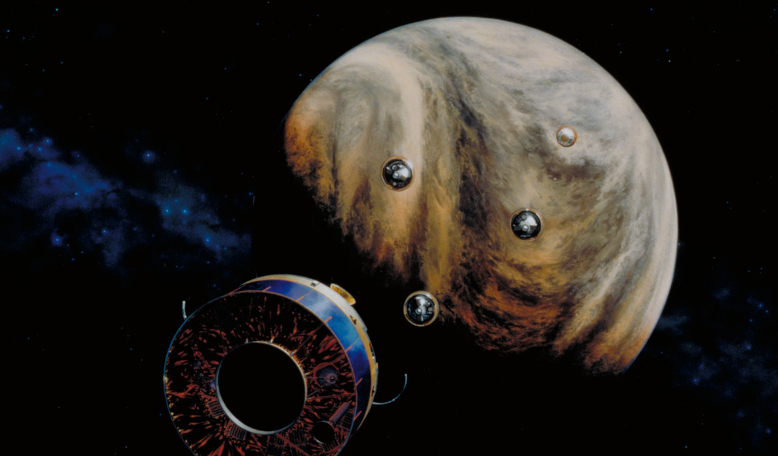Last week’s sensational news that scientists have detected signs of microbes living in the cloud tops of Venus has taken another turn as a different team of researchers combing through archival data collected by NASA’s Pioneer Venus Multiprobe say that the data supports the presence of phosphine (PH3), but reiterate its origins remain unknown.
Back in 1978, NASA launched two spacecraft to study Venus as part of the agency’s Pioneer programme; an Orbiter and the Multiprobe.
The Orbiter launched first in May and slightly less than three months later in August, the Multiprobe spacecraft took to the skies from the Kennedy Space Center via an Atlas-Centaur launch vehicle.
As the craft encountered Venus, the 875 kg (1930 lb) Multiprobe separated into 5 separate vehicles; the probe transporter (referred to as the Bus), a large atmospheric entry probe (called Sounder), and three identical small probes (called North, Day, and Night).
All of the probes entered the Venusian atmosphere within 11 minutes of each other, and sent data back to Earth as they descended toward the surface over an approximate hour long period.
Tucked aboard the Sounder (the large probe) were seven experiments, contained within a sealed spherical pressure vessel, one of which was the LNMS – a neutral mass spectrometer designed to measure the planet’s atmospheric composition.
In a nutshell, mass spectrometry accurately measures the mass of different molecules within a sample and so therefore can help identify what those molecules are.
As the LNMS descended through Venus’ atmosphere it detected a number of molecules at altitudes of 50 - 60 kilometres, or within the lower and middle clouds of Venus – the region which has been identified as a potential habitable zone, including OH (hydroxide), CH4 (methane), HS (sulfanyl) amongst others and a few atomic species.
Atomic phosphorous was also detected, however, compounds of phosphorous such as PH2 and PH3 were not reported in the initial analyses note the team who have now done a reanalysis of the Venus Pioneer data.
This re-evaluation, performed by Rakesh Mogul at California State Polytechnic University, Pomona, and colleagues has led the team to report that a molecular that was initially identified as H2S (hydrogen sulfide) may actually be PH3 (phosphine).
“This re-evaluation of Venus’ mass spectra shows the detection of atomic phosphorous as a fragmentation product from a neutral gas. Moreover, the spectra show a tantalizing possibility for the presence of PH3,” write the team in their paper which is published on the preprint Arxiv database and has yet to be peer-reviewed by other scientists.
“These total interpretations also lend support to the presence of chemicals potentially out of equilibrium in Venus’ clouds (e.g., PH3, O2, CH4, C3H4, NO, H2, and H2O2). We believe this to be an indication of chemistries not yet discovered, and/or chemistries potentially favorable for life,” the team add.
The team also note that the re-evaluated abundance of PH3 is perhaps consistent with figures provided by the researchers who made the announcement last week of their phosphine discovery.
But, warns another scientist, while more confirmation is needed for a robust detection of PH3, this is not necessarily it.
“The signals that they [Rakesh Mogul and team] are trying to separate are very small and very close together,” Michael Radke, a planetary scientist said via Twitter.
If it is in this spectrum, it would be best if it could be detected at more than one altitude, to make absolutely sure it’s not just noise, added Radke, who is studying the formation of cloud and haze particles in Venus’ atmosphere.
Fortunately, scientists might not have that long to wait for further phosphine detections as both ESA’s BepiColombo and NASA’s Parker Solar probe are both on target to flyby Earth’s twin planet in December 2020 and February 2021 respectively.
Whether it will be achievable or not is another question though as neither missions were initially designed to scan Venus’ atmosphere.
Another chance might lie with Japan’s Akatsuki space probe which is currently in orbit around Venus.
Although the craft initially experienced problems entering the right orbit and ended up circling the Sun for five years, it is now in an extended operations phase around Venus and is still collating data.
Again, whether it can succeed if the others fail is unknown as although Akatsuki has instruments capable of detecting compounds at ultraviolet (UV) and infrared (IR) wavelengths, they do not quite cover the strongest wavelength band that phosphine is found in (4-4.8 microns).











